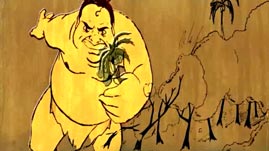Teachers' Domain - Digital Media for the Classroom and Professional Development
User: Preview

Source: GEF Pacific IWRM Project
This video adapted from the Secretariat of the Pacific Community tells the legend of Uab, a boy who grew into a giant as he ate everything around him. Uab became so heavy that the island he lived on began to sink. His appetite caused other problems, including a change in weather patterns and damage to coral reefs. Left with no choice, the islanders eventually killed Uab. This legend mirrors what is happening today globally and in the Pacific Island region: the unsustainable use of land, marine, and freshwater resources is having unwanted effects. In response, Palau is taking steps to help conserve natural resources for future generations.
Vocabulary:
Around the world, cultural myths and legends share common themes. There are stories about the origins of the Earth, the first humans, or the features of the landscape. In indigenous cultures, these stories have influenced how people live with each other and with their environment. However, on many Pacific islands, outside influences have increased people’s desire to make money from their islands’ natural resources. This has created serious problems. The effects of global climate change will only worsen these problems.
In recent years, traditional knowledge has made a comeback. The idea that indigenous people should be stewards of their land and sea has been central to traditional resource management. Cultural myths and legends that contain traditional knowledge can remind people of their connection to the natural world.
If people understand their surroundings better, they can recognize the impact they have on the natural world. This recognition can then guide them to think of ways to protect natural resources. Traditional knowledge can be very specific. For example, stories can provide information about where and when to harvest certain species of fish. The stories can be adapted and used as part of modern management strategies.
Some traditional stories already contain a stewardship message, as this video shows. The Palauan Uab legend is a story about what can happen when humans act in ways that harm the land. As Pacific Island communities try to adapt to the changes occurring around them, traditional stories can help inspire young islanders to act. They can also help islanders who have left their native villages reconnect with their culture and help solve some important challenges.
Here is a suggested way to engage students with this video and with activities related to this topic.
Small group activity or individual research project: Ask students to research and describe myths from their own and other cultures. To demonstrate how a message can be coded into a traditional myth, ask students to create a myth that would encourage people to recycle. Have them compare their stories and identify the elements their stories have in common with the myth of the giant Uab.
 Loading Standards
Loading Standards